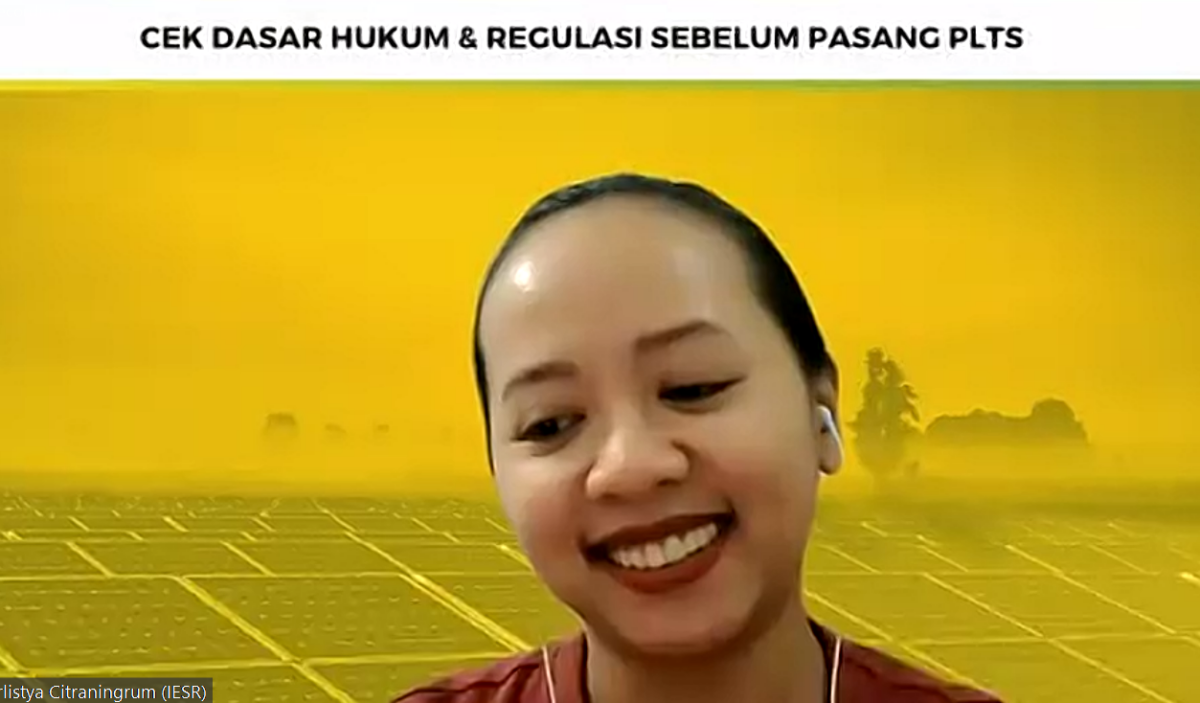Jakarta, March 21, 2023 – Currently, the use of rooftop solar power plants is being encouraged because it is believed to be able to meet future energy needs. As a mainstay of pursuing a 23% renewable energy mix in 2025, rooftop solar PVis targeted to be installed up to 3.6 Giga Watt (GW). To support this, the government continues to intensively promote the installation of rooftop solar PVin both households and industry. Marlistya Citraningrum, Program Manager for Sustainable Energy Access, Institute for Essential Services Reform (IESR) explained there had been a long journey for solar energy in Indonesia. This started before the 1980s when development and research on solar energy began. Until then, the use of rooftop solar PVhas developed until nowadays.
“Before the 2018s, there was a PT PLN board of directors regulation regarding the use of photovoltaic electricity by PLN customers. The law contains that the installation of rooftop solar PVis allowed to operate in parallel with the PLN network, the export of excess electricity is permitted with a net-metering scheme, a 1: 1 rate,” said Marlistya in the EBT Zone event on Tuesday (21/3/2023).
Furthermore, Marlistya mentioned, afterwards, there was Minister of Energy and Mineral Resources Regulation No. 49 of 2018 concerning the use of the rooftop solar PV system by consumers of PT PLN. The regulation stipulates that the installation of rooftop solar PV connected to a network is permitted, the maximum capacity of rooftop solar PV is 100 of the installed power, measured from the ability of the inverter, the export of excess electricity is allowed with a net-metering scheme, a rate of 1: 0.65. In addition, there is an offset calculation at the end of the month, and excess deposits are allowed for up to three months. Technical and licensing procedures are explained, and a parallel fee is imposed for industrial customers.
“The Minister of Energy and Mineral Resources Regulation can be referred to as the “original” rooftop solar PV regulation. However, there was a change in 2019, where installing a rooftop solar PV requires an operating permit. Referring to the Minister of Energy and Mineral Resources No 12/2019, installations <500 kVA do not require an operating permit. Then, parallel industrial fees for industrial customers were reduced to 5 hours/month from 40 hours/month, and emergency costs were eliminated,” stated Marlistya.

With these various regulations, said Marlistya, there has been significant growth in rooftop solar power in the 2018-2020 range. Different factories install rooftop solar PV. With this growth, a new regulation emerged:MEMR regulation No. 26 of 2021. This regulation regulates that network-connected rooftop PLTS are allowed in all areas where public interest business licence (IUPTLU) holders are permitted. Net-metering scheme, 1:1 rate, offset calculation is done at the end of the month, and excess deposits are allowed up to six months.
“Unfortunately, this regulation will only be announced in 2022. When MEMR regulation No. 26 of 2021 was issued, there was an installation capacity limit of 10-15% or lower in all regions of Indonesia, as well as a fixed electricity export tariff of 0.65 according to the old MEMR Regulation. This limitation can be found when a consumer applies for a permit to install a rooftop solar PVat his home, then there is a reply letter from PLN containing these restrictions,” said Marlistya.
This capacity limitation, said Marlistya, occurs universally in Indonesia until consumer complaints arise regarding this matter through association institutions. Given these conditions, 2022 will be the first year in which the development of rooftop solar PVhas decreased compared to the previous year. Citing data from the Ministry of Energy and Mineral Resources for 2023, mentioned Marlistya, the growth of rooftop solar PV customers in 2018 reached 609, 1,064 in 2019, 1,334 in 2020, 1,787 in 2021, and 1,667 in 2022.

